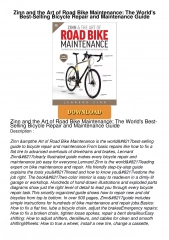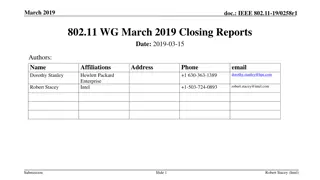The Selling Process: Closing Techniques and Strategies
The chapter delves into the art of closing a sale successfully, emphasizing the importance of initiating the closing process early on in the sales journey. It discusses negotiating for mutual benefit, overcoming closing challenges, and accepting job offers effectively. The significance of follow-up in nurturing customer relationships and enhancing satisfaction is highlighted, along with tips for post-acceptance job follow-up. Various types of closing techniques are explored, including direct request close, benefit summary close, and assumptive close, among others. Additionally, the complexities of closing in high-value transactions are examined, along with strategies for navigating complex sales processes.
Download Presentation

Please find below an Image/Link to download the presentation.
The content on the website is provided AS IS for your information and personal use only. It may not be sold, licensed, or shared on other websites without obtaining consent from the author.If you encounter any issues during the download, it is possible that the publisher has removed the file from their server.
You are allowed to download the files provided on this website for personal or commercial use, subject to the condition that they are used lawfully. All files are the property of their respective owners.
The content on the website is provided AS IS for your information and personal use only. It may not be sold, licensed, or shared on other websites without obtaining consent from the author.
E N D
Presentation Transcript
Sales Leadership Management Chapter 7: The Selling Process Closing and Follow up Creative Commons Attribution-NonCommercial-ShareAlike 4.0 International (CC BY-NC-SA 4.0) Creative Commons Attribution-NonCommercial-ShareAlike 4.0 International (CC BY-NC-SA 4.0) Unless otherwise noted, this work is licensed under a Creative Commons Attribution-NonCommercial- ShareAlike 4.0 International (CC BY-NC-SA 4.0) license. Feel free to use, modify, reuse or redistribute any portion of this presentation.
7.0 Learning Outcomes In this chapter, we will: Discuss how to successfully close a sale. Describe how to negotiate so that all parties win. List suggestions to assist with closing challenges. Explain how to negotiate and accept the right job offer. Outline what follow-up entails and why it is so important. Discuss how customer satisfaction relates to customer loyalty. Describe the follow up steps after accepting a job offer.
7.1 Closing Starts At The Beginning Closing bringing the sale to fruition or getting the sale- or getting the order, starts at the beginning of the selling process, long before you even come in contact with the prospect. Start Strong The closing in sales is the beginning of the relationship with the customer, not the end of the selling process. Closing Time The close builds on everything that has already taken place throughout the selling process rapport, trust, information sharing. ABC or ABO? Always Be Closing (ABC) or Always Be Opening (ABO) Always Be Opening-While you always have your eye on the prize of closing a sale, the focus is to extend your relationship with your prospect beyond selling to servicing and being a business partner.
7.1 Closing Starts At The Beginning Ask for the Order When you focus on delivering value to your prospects and customers, you have earned the right to close or ask for the sale. Simple questions like Will delivery on Tuesday work for you? or Should we start your service the week of the twenty-first? help you and the customer focus on moving from the sales presentation to the delivery of the product or service. When to Close The best way to know when to close is to listen and watch. Tips for Closing with a Committee Have a specific, measurable, actionable, realistic, and time-bound (SMART) objective. Know each committee member s name and role in the decision. Identify your champion on the committee. Leverage your champion to help sell the committee for you (Atlas, n.d.). 1. 2. 3. 4.
7.1 Closing Starts At The Beginning Types of Closes Direct Request Close Benefit Summary Close Assumptive Close Alternative-Choice Close Compliment or Vanity Close Combination Close Closing Complex Sales A complex sale is a term that usually refers to high-value purchases. The Four Phases of a Complex Sale: Discover/ Diagnose/ Design/ Deliver Seven-Step Selling Process: Close the Sale by Freddy Vale CC BY-NC-SA 2.0
7.2 Collaborate To Negotiate If you ask for something before a contract is signed, it s called negotiating. Negotiate to Win-Win-Win Building Trust Gaining Commitment Managing Opposition The Three Elements of Negotiation Information Power Time The Three Elements of Negotiation by Freddy Vale, CC BY-NC-SA 2.0
7.2 Collaborate To Negotiate Steps of the Negotiation Process Steps Activities 1. Pre-negotiation Get in the right frame of mind; be confident about the value of your product. Do your homework; know who s sitting on the other side of the table and what s important to them Set pre-negotiation goals; identify the minimum that you will accept for the deal and be ready to walk away if you can t get it. Identify an offer that is high than your pre-negotiation goals to allow some room for negotiating Make your initial offer and hold firm. Identify other currencies with which to negotiate to reach common ground. Be specific and identify every element of the deal in detail; put it on paper to avoid surprises later. If you encounter a deadlock, put the issue aside and come back to it at a later time in the negotiation. Avoid getting emotionally involved; be ready to walk away if you can t make a deal that is mutually beneficial. Celebrate with all appropriate people; consider dinner, cocktails, or another get-together. Use the negotiation to build your relationship. Record what you ve learned. Be ready for the next negotiation. Table 7.2.1 Three Steps of the Negotiation Process 2. Negotiation 3. Post-negotiation
7.3 Trial Closes A trial close helps test the water to get an idea on what the customer is thinking about the product or service. Trial closes are low risk because it is asking for an opinion or checking on how well you handled an objection and it is not asking for a decision from the client. Don t just close once. It s important to consistently close through the sales presentation using trial closes and a variety of techniques. 1. Not asking for what you want. This seems straightforward but as a salesperson might fear rejection, they soften their ask to minimize the change of hearing no or they don t write out clear objectives for the sales call and leave without really getting what they want. 2. Using statements instead of questions. This comes back to listening more than speaking and using good communication methods. 3. Closing to someone who can t deliver. This challenge results from not doing your research to properly qualify a lead or not understanding the decision criteria in a business to business sales call. 4.
7.4 Selling U: Negotiating To Win For Your Job Offer Know What You re Worth Establish Your Value Early Compensation versus Salary Starting Out at a Start-Up Timing Is Everything Receiving the Offer Evaluating the Offer Negotiating the Offer Photo by Maura Nicolaita, Pixabay
7.5 Follow-up: The Lasting Impression Follow-up entails everything that takes place after the sale is closed. It also includes your ongoing relationship with your customer. Relationship is the key word here. Areas That Require Follow-Up Schedule and ensure that installation is implemented correctly Schedule delivery and confirm that it was made correctly and on time Schedule and conduct training Conduct credit checks Sign contracts Add customers to all appropriate company correspondence Send welcome package to new customer Introduce key people to new customer Schedule status call with customer Generate invoice
7.5 Follow-up: The Lasting Impression How you proactively handle follow-ups will make all the difference in your relationships and your sales. While follow-up is the last step in the selling process, it is the step that can have the most impact on your customer. Think about your follow-up plan with the following five elements in mind: Demonstrate your personal commitment and connection to the customer. Deliver as promised. Add value to your customer s business. Get feedback. Make your customers into fans. When a salesperson responds quickly to a service failure and delights the customer with the outcome, it is called heroic recovery response to a service failure that delights the customer. 1. 2. 3. 4. 5.
7.6 Customer Satisfaction Isnt Enough Customer loyalty and retention are the holy grail in sales. Companies that focus on creating customer loyalty usually invest in developing an effective customer feedback loop, a formal process for gathering, synthesizing, and acting on customer feedback. The most successful customer feedback loops are simple, focus on understanding what is important to customers, and empower front-line employees. Successful companies have found that customers can be more than customers; they can be advocates, supporters, promoters, and fans. Net Promoter Score is based on asking customers the ultimate question: How likely are you to recommend this product or company to a colleague or friend? The response is based on a ten-point scale and categorizes responses in promoters (scores of 9 or 10), passives((scores of 7 or 8) and detractors (scores of 0 to 6). A company s Net Promoter Score is determined by taking the percentage of promoters and subtracting the percentage of detractors.
7.7 Selling U: What Happens After You Accept The Offer? Just as you should never assume the sale is closed, the same is true about your job. Corporate world is very different from the classroom. Five Things You Should Do Before You Start Your New Job 1. Say thank you 2. Continue to do your research on the company 3. Dress for success 4. Plan your route 5. Walk in with a smile Five Tips to Help You Get Your Feet on the Ground at Your New Job 1. Listen, observe, and ask questions 2. Avoid office gossip 3. Find a mentor 4. Stand out 5. Fine-tune your writing and speaking skills.
7.8 Key Takeaways & Terms Alternative-choice close Always Be Closing (ABC) Always Be Opening (ABO) Assumptive close Benefit summary close Combination close Compensation Complex sale Compliment (or vanity) close Counteroffer Customer feedback loop Deadlock Detractors Direct request close Follow-up Heroic recovery Negotiating Net Promoter Score (NPS) Offer letter Passives Pre-negotiation goals Promoters Salary Trial close























